Your Washing Machine Leaves Black Or White Marks On Your Clothes

Are you finding marks on your clothes when you sort your washing after taking it out the machine? Here we'll explain what the underlying cause might be.
THE POSSIBLE CAUSES OF THIS ISSUE:
-
Too much washing
-
A blocked standpipe
-
Too much conditioner
-
A damaged drive belt
-
Worn bearings
-
The heating element is caked in deposits
-
Mould on the door seal
-
The plumbing system is antiquated
Too much washing
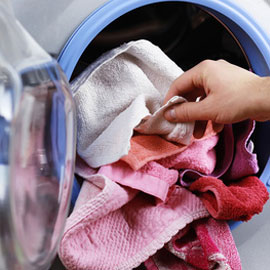 Comply with the manufacturer's instructions concerning the maximum weight of clothing that you can put in your machine. You should be able to insert your arm between the load and the top of the door seal. If you load the machine with too much washing, the detergent will not be able to dissolve efficiently, causing it to leave marks on the clothes, especially if you are using powder type detergent.
Comply with the manufacturer's instructions concerning the maximum weight of clothing that you can put in your machine. You should be able to insert your arm between the load and the top of the door seal. If you load the machine with too much washing, the detergent will not be able to dissolve efficiently, causing it to leave marks on the clothes, especially if you are using powder type detergent.
A blocked standpipe
 Automatic syphoning can occur during the draining process. This phenomenon causes the dirty water to flow back into the washing machine in the reverse direction. The consequence of this is that rinsing will be impaired, leaving traces of detergent on the clothing. Make absolutely sure your drain hose is at least 65 cm above the ground and is inserted 10 cm into the plumbing standpipe.
Automatic syphoning can occur during the draining process. This phenomenon causes the dirty water to flow back into the washing machine in the reverse direction. The consequence of this is that rinsing will be impaired, leaving traces of detergent on the clothing. Make absolutely sure your drain hose is at least 65 cm above the ground and is inserted 10 cm into the plumbing standpipe.
Too much conditioner
 If you put too much conditioner in the detergent drawer, the liquid may overflow and spill directly onto the washing at the beginning of the wash programme. This will create stains, and these will fix on your clothes. They will then be difficult to remove. We recommend filling no higher than the maximum level indicated on the detergent tray. If you are not sure whether this is the cause of the problem, try temporarily washing without any conditioner, or use a 2-in-1 type product (detergent + fabric conditioner).
If you put too much conditioner in the detergent drawer, the liquid may overflow and spill directly onto the washing at the beginning of the wash programme. This will create stains, and these will fix on your clothes. They will then be difficult to remove. We recommend filling no higher than the maximum level indicated on the detergent tray. If you are not sure whether this is the cause of the problem, try temporarily washing without any conditioner, or use a 2-in-1 type product (detergent + fabric conditioner).
A damaged drive belt
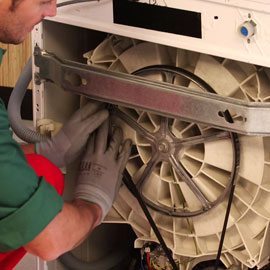 The drive belt connects the motor spindle to the drum pulley, enabling the drum to rotate. If it has snapped or simply come free from it is mounting, the detergent or conditioner will fall directly onto the washing in the drum, which won’t be able to rotate anymore. This can result in stains. If the drum stops turning during a wash cycle, we recommend you first to try putting the drive belt back in place. If the problem still persists after that, replace the belt. The drive belt is located behind your washing machine's access panels.
The drive belt connects the motor spindle to the drum pulley, enabling the drum to rotate. If it has snapped or simply come free from it is mounting, the detergent or conditioner will fall directly onto the washing in the drum, which won’t be able to rotate anymore. This can result in stains. If the drum stops turning during a wash cycle, we recommend you first to try putting the drive belt back in place. If the problem still persists after that, replace the belt. The drive belt is located behind your washing machine's access panels.
Purchase a washing machine belt
Worn bearings
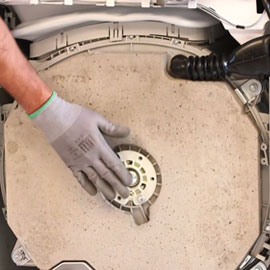 The bearings enable the drum to rotate freely on its axis. If they are worn, you will hear a metallic scraping sound when the machine is spinning. You will also start to see black or rust-colored marks appearing on your clothes. When this occurs, it is a good idea to visually inspect the bearings and replace them if you spot any signs of rust.
The bearings enable the drum to rotate freely on its axis. If they are worn, you will hear a metallic scraping sound when the machine is spinning. You will also start to see black or rust-colored marks appearing on your clothes. When this occurs, it is a good idea to visually inspect the bearings and replace them if you spot any signs of rust.
Purchase a washing machine worn bearings
The heating element is caked in deposits
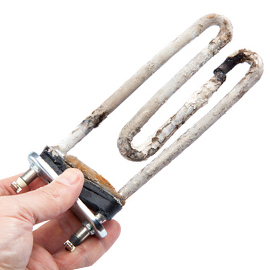 The heating element heats the water in the washing machine. Over time, it can become caked in deposits, especially if you often use 30° or 40° wash programmes. Doing this will lead to detergent and conditioner building up on the heating element's surface. Eventually, these deposits will break off and end up on your clothes, causing greyish marks. To avoid this, we recommend both regularly descaling your machine and running a 90° wash programme at least once a month. If this has no effect on the problem, remove the heating element and inspect it. If these symptoms are present, clean or replace it.
The heating element heats the water in the washing machine. Over time, it can become caked in deposits, especially if you often use 30° or 40° wash programmes. Doing this will lead to detergent and conditioner building up on the heating element's surface. Eventually, these deposits will break off and end up on your clothes, causing greyish marks. To avoid this, we recommend both regularly descaling your machine and running a 90° wash programme at least once a month. If this has no effect on the problem, remove the heating element and inspect it. If these symptoms are present, clean or replace it.
Purchase a washing machine heating element
Mould on the door seal
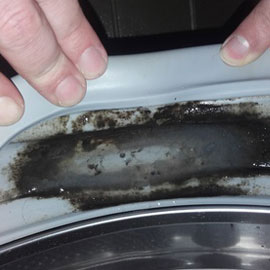 Using only 30° or 40° wash programmes will not remove the deposits of detergent and conditioner that build up on the tub and door seal. If you don't want to see traces of mould appearing on your clothes and staining them, be careful to regularly wipe the seal with a dry cloth. We recommend running a 90° programme at least once a month and regularly descaling your machine. If the door seal is in bad condition and the problem does not improve, despite giving it a good cleaning, replace it.
Using only 30° or 40° wash programmes will not remove the deposits of detergent and conditioner that build up on the tub and door seal. If you don't want to see traces of mould appearing on your clothes and staining them, be careful to regularly wipe the seal with a dry cloth. We recommend running a 90° programme at least once a month and regularly descaling your machine. If the door seal is in bad condition and the problem does not improve, despite giving it a good cleaning, replace it.
Purchase a washing machine door seal
The plumbing system is antiquated
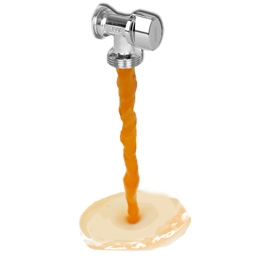 If your house has fairly antiquated plumbing, or if external or internal work has been carried out on the pipework, the water may become reddish in colour and could stain your clothes. If this is the case, we recommend calling in a plumber or testing your machine again once the work has been completed.
If your house has fairly antiquated plumbing, or if external or internal work has been carried out on the pipework, the water may become reddish in colour and could stain your clothes. If this is the case, we recommend calling in a plumber or testing your machine again once the work has been completed.
